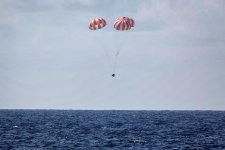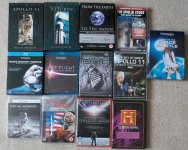You are using an out of date browser. It may not display this or other websites correctly.
You should upgrade or use an alternative browser.
You should upgrade or use an alternative browser.
** The Official Space Flight Thread - The Space Station and Beyond **
- Thread starter Cosimo
- Start date
More options
Thread starter's postsTime to delve into the history books and recall the Gemini 4 mission during which on June 3, 1965, Ed White became the first American to conduct a spacewalk:
The EVA started over the Pacific Ocean near Hawaii and lasted 23 minutes, ending over the Gulf of Mexico. Initially, White propelled himself to the end of the 8-meter tether and back to the spacecraft three times using the hand-held gun. After the first three minutes the fuel ran out and White maneuvered by twisting his body and pulling on the tether.
Great on board video of the SpaceX pad abort test:
Well I wasn't expecting usa to sort this issue out so fast.
http://www.washingtonpost.com/blogs...-space-mining-the-future-is-here/?tid=rssfeed
http://www.washingtonpost.com/blogs...-space-mining-the-future-is-here/?tid=rssfeed
Any asteroid resources obtained in outer space are the property of the entity that obtained such resources, which shall be entitled to all property rights thereto, consistent with applicable provisions of Federal law.
scientific instruments announced fir Europa mission.
I hope this actually goes ahead and paves a way for some sort of submarine.
I hope this actually goes ahead and paves a way for some sort of submarine.
Plasma Instrument for Magnetic Sounding (PIMS) -- principal investigator Dr. Joseph Westlake of Johns Hopkins Applied Physics Laboratory (APL), Laurel, Maryland. This instrument works in conjunction with a magnetometer and is key to determining Europa's ice shell thickness, ocean depth, and salinity by correcting the magnetic induction signal for plasma currents around Europa.
Interior Characterization of Europa using Magnetometry (ICEMAG) -- principal investigator Dr. Carol Raymond of NASA’s Jet Propulsion Laboratory (JPL), Pasadena, California. This magnetometer will measure the magnetic field near Europa and – in conjunction with the PIMS instrument – infer the location, thickness and salinity of Europa’s subsurface ocean using multi-frequency electromagnetic sounding.
Mapping Imaging Spectrometer for Europa (MISE) -- principal investigator Dr. Diana Blaney of JPL. This instrument will probe the composition of Europa, identifying and mapping the distributions of organics, salts, acid hydrates, water ice phases, and other materials to determine the habitability of Europa’s ocean.
Europa Imaging System (EIS) -- principal investigator Dr. Elizabeth Turtle of APL. The wide and narrow angle cameras on this instrument will map most of Europa at 50 meter (164 foot) resolution, and will provide images of areas of Europa’s surface at up to 100 times higher resolution.
Radar for Europa Assessment and Sounding: Ocean to Near-surface (REASON) -- principal investigator Dr. Donald Blankenship of the University of Texas, Austin. This dual- frequency ice penetrating radar instrument is designed to characterize and sound Europa's icy crust from the near-surface to the ocean, revealing the hidden structure of Europa’s ice shell and potential water within.
Europa Thermal Emission Imaging System (E-THEMIS) -- principal investigator Dr. Philip Christensen of Arizona State University, Tempe. This “heat detector” will provide high spatial resolution, multi-spectral thermal imaging of Europa to help detect active sites, such as potential vents erupting plumes of water into space.
MAss SPectrometer for Planetary EXploration/Europa (MASPEX) -- principal investigator Dr. Jack (Hunter) Waite of the Southwest Research Institute (SwRI), San Antonio. This instrument will determine the composition of the surface and subsurface ocean by measuring Europa’s extremely tenuous atmosphere and any surface material ejected into space.
Ultraviolet Spectrograph/Europa (UVS) -- principal investigator Dr. Kurt Retherford of SwRI. This instrument will adopt the same technique used by the Hubble Space Telescope to detect the likely presence of water plumes erupting from Europa’s surface. UVS will be able to detect small plumes and will provide valuable data about the composition and dynamics of the moon’s rarefied atmosphere.
SUrface Dust Mass Analyzer (SUDA) -- principal investigator Dr. Sascha Kempf of the University of Colorado, Boulder. This instrument will measure the composition of small, solid particles ejected from Europa, providing the opportunity to directly sample the surface and potential plumes on low-altitude flybys.
Great docking video taken by the crewmembers aboard the Soyuz TMA-16M spacecraft which docked to the station in March:
Soyuz docked to the Poisk module (also known as the Mini-Research Module 2) on the space-facing side of the Russian Service Module. The spinning object in view is an antenna that is part of the automatic rendezvous and docking system known as KURS.
Soyuz docked to the Poisk module (also known as the Mini-Research Module 2) on the space-facing side of the Russian Service Module. The spinning object in view is an antenna that is part of the automatic rendezvous and docking system known as KURS.
Yesterday's Ariane 5 VA223 (two telecom satellites, DirecTV-15 and Sky Mexico-1) launch from Europe’s Spaceport in French Guiana:
A nice collection of photos dating from the Mercury to the Apollo missions:
They can be downloaded here:
http://dropcanvas.com/7ca6u
They can be downloaded here:
http://dropcanvas.com/7ca6u
They are back in contact with solar sail. lets hope they can open the sail up and at least test that.
Also live is another BPM5 rocket motor test by Copenhagen Sub Orbital. I've only just woke up so not sure where in the test program they are.
Our LightSail called home! It’s alive! Our LightSail spacecraft has rebooted itself, just as our engineers predicted. Everyone is delighted. We were ready for three more weeks of anxiety. In this meantime, the team has coded a software patch ready to upload. After we are confident in the data packets regarding our orbit, we will make decisions about uploading the patch and deploying our sails— and we’ll make those decisions very soon. This has been a rollercoaster for us down here on Earth, all the while our capable little spacecraft has been on orbit going about its business. In the coming two days, we will have more news, and I am hopeful now that it will be very good.
Also live is another BPM5 rocket motor test by Copenhagen Sub Orbital. I've only just woke up so not sure where in the test program they are.
Last edited:
Time for a little reorganisation as the Permanent Multipurpose Module was robotically relocated from the Earth-facing port of the Unity module to the forward port of the Tranquility module in preparation for the arrival of new visitors:
Some more history with a look back at all that:
Soldato
Why is it that both of my kids, 7 and 12, have learnt about space and the planets yet neither of them have heard of the Voyager probes....
Slightly off topic but people ask about what videos you can watch about the subject so from Music, Box Office, TV & Books:

My "NASA" collection:
The History Channel one is "Beyond the Moon:Failure is not an Option 2". The remastered and restored Carl Sagan's Cosmos is not shown but is a must. The BBC "Space Race" is very good covering the period from WW2 to the moon landings.

Down memory lane again, this time looking back at Mission Control:
More:
http://www.nasa.gov/centers/johnson/home/index.html
More:
http://www.nasa.gov/centers/johnson/home/index.html
More history as 50 years ago on the 3rd June 1965 Ed White became the first American to walk in space:
Continuing with space walks, how to get "suited up":



